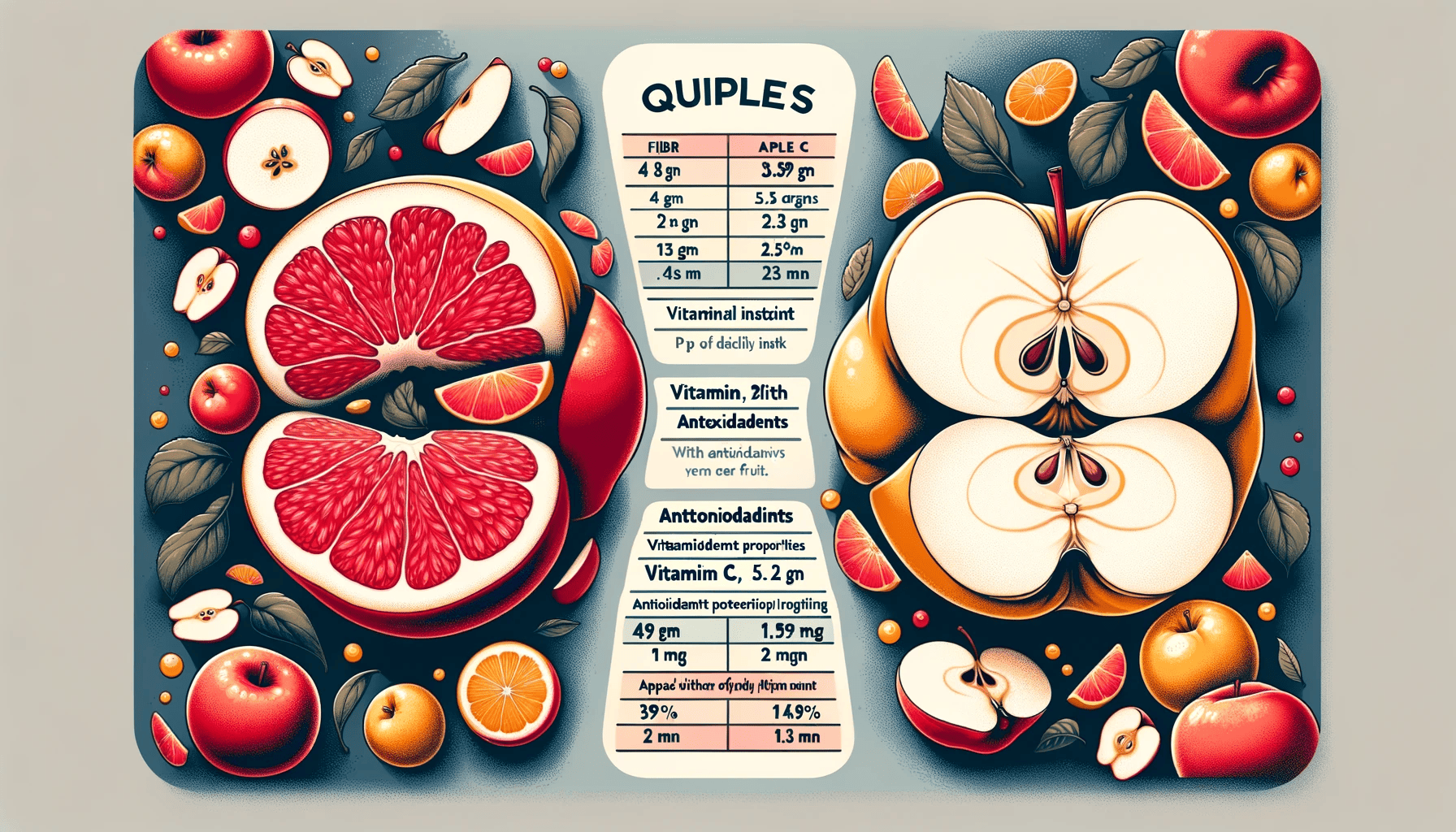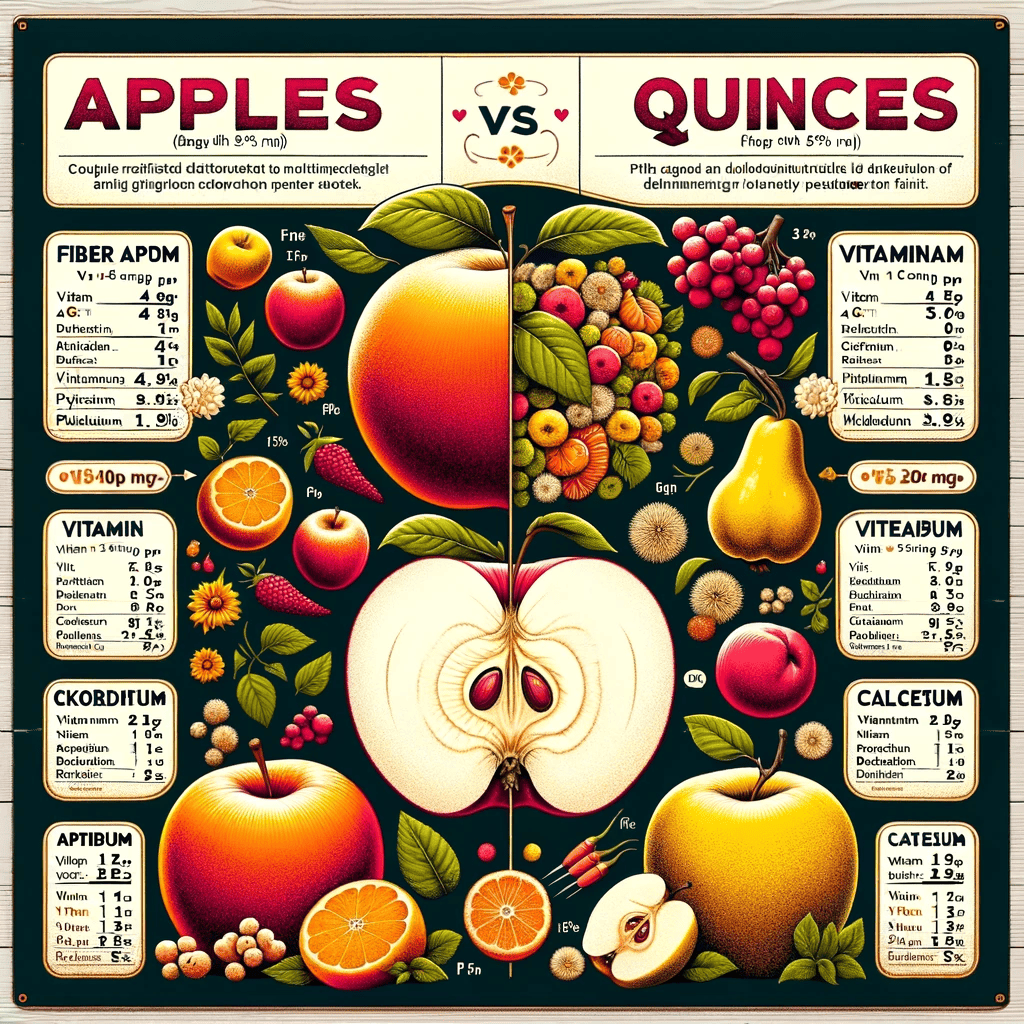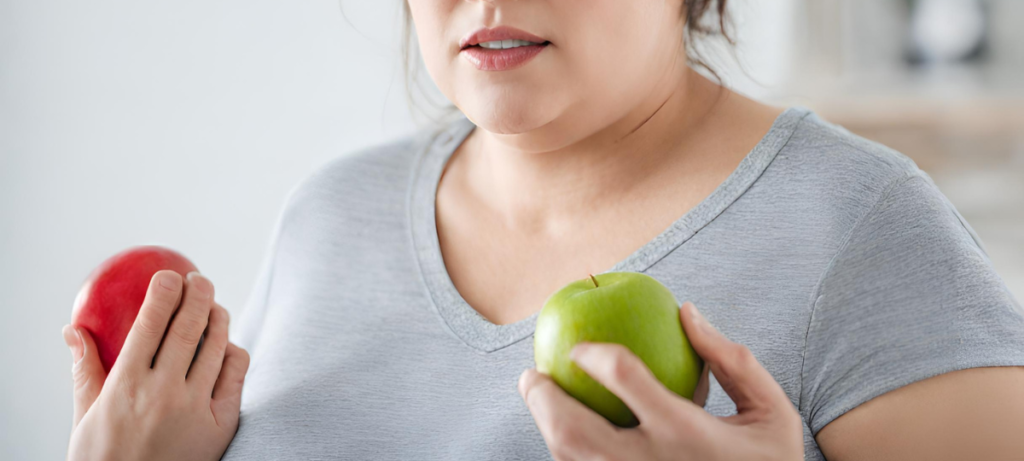
Apples and quinces share many important characteristics that identify them in the kingdom of fruits.
Their flexibility, sound delectableness, and nourishment are the biggest –but not the exclusive- characteristics of these fruits.
Our objective is to determine which fruit has better nutritional value . To complete this objective we will compare the nutritional values of each fruit. Comparing includes taking a look at the nutrients in each fruit and also the health benefits each fruit provides.
Overall: Apples vs Quinces

| Nutrient | Apples | Quinces |
|---|---|---|
| Fiber | 4g per medium size | 5.3g per medium size |
| Vitamin C | 8% daily intake | 2% daily intake |
| Antioxidants | Flavonoids, Polyphenols | High in Phenolic Compounds |
| Potassium | 195 mg per medium size | 197 mg per medium size |
| Calcium | 11 mg per medium size | 19 mg per medium size |
Fiber:
Fiber is necessary in one’s diet for a healthy digestive system and for the prevention of many chronic diseases. You can find fiber in whole grains, fruits, vegetables, and legumes. The daily recommended amount of fiber is 25 grams for women and 38 grams for men. One can lower the risk of heart disease, diabetes and stroke with a high-fiber diet.
Apples have been recognized for their dietary fiber, but apples with their 4 grams of fiber per medium size apple are overshadowed by quinces at 5.3 grams of fiber per medium size fruit.
Vitamin C:
Vitamin C is a really significant Vitamin in our diet to work on the immune system helping to keep a person healthy besides being found in oranges, other fruit and vegetables have this vitamin except for a few foods which is an added bonus.
In terms of nutritional content, both quinces and apples contain vitamin C, however the content differs. The typical medium-sized apple contains about 8% of the daily recommended intake for vitamin C. Compare that to the 2% of the typical quince and it would seem that the apple holds a slightly higher advantage against the quince.
Antioxidants:
Antioxidants are groups of compounds that guard the body against free radicals and oxidants thereby preventing cell damage in the body thus prevent many diseases. Many companies sell Anti-oxidants some of these companies are Forever Living.
Some researches have shown that antioxidants can help your body neutralize free radicals and keep you healthy. Free radicals are formed naturally in the body and are a cause of major damage mosquitoes, or any other fish, reptiles, or insects that will eat the larvae or adults.
All mosquitoes go through four life cycles, these include: egg, larva, pupae and adult. Some types of mosquitoes can take a life time of two months whereas some can take life time of 2 – 3 weeks.
The malaria parasite, plasmodium, is transmitted from person to person only by the female mosquito of the species anopheles. Female mosquitoes rest indoors after a blood meal, compared to the out of doors resting characteristics of less dangerous species.
Antioxidants and Their Importance
Antioxidants are truly significant for what they do to protect the body from the hazardous effects and damage that can be caused by a substance called Free Radicals.
Apples and quinces are two fruits which are commonly dealt with in terms of the properties of the fruit’s antioxidants.
Apples are packed with many types of antioxidizing agents such as flavonoids and polyphenols which in turn give them the multiple different colors they come in.
Whereas a quince fruit contains high levels of Phenolic Compounds which have a wide range of health benefits.
Potassium:
Potassium is a vital mineral for your body to operate correctly; it is in charge of maintaining your blood pressure, regular muscle contractions, and a proper functioning nervous system. To keep yourself healthy and well, it is crucial that you include foods that contain high levels of potassium.
This mineral is vital in regulating our blood pressure, making it crucial to heart function as well. In this comparison, the apple and quince are very similar in their potassium content.
The average apple, in medium size, contains about 195 milligrams of potassium. The average quince, in medium size, contains 197 milligrams of potassium.
Calcium:
Calcium, a mineral necessary for the human body to function properly, aids in the development and maintenance of healthy teeth and bones.
Calcium plays a role in muscle function, aids in hormone secretion, nerve transmission, and even works at neutralizing acid within the body.
Calcium deficiency can result in weak bones and or even osteoporosis, therefore it is wise to devote some thought to consuming enough calcium via protein-packed foods, and necessary vitamins and minerals. should you not receive enough, supplementation may be required.
Even though an apple or even a quince does not appear to be too much supply of calcium as well as calcium in dairy or even leafy greens, they also provide calcium to the diet program.
A medium-sized apple supplies about 11 milligrams or even calcium as well as a medium-sized quince has about 19 milligrams.
Others:
Sugar Content: Comparing the natural sugar content in both fruits can be insightful, especially for those monitoring their sugar intake.
Caloric Value: The number of calories in each fruit can be significant for those tracking their daily caloric intake.
Vitamin A: This vitamin is crucial for vision, the immune system, and reproduction. Comparing the Vitamin A content in both fruits can be interesting.
Vitamin K: Important for blood clotting and bone health, the amount of Vitamin K in each fruit could be a point of comparison.
Magnesium: This mineral helps with muscle and nerve function, blood sugar levels, and blood pressure. It would be beneficial to compare the magnesium content.
Iron: Essential for blood production, comparing the iron content in apples and quinces can be valuable, especially for people with dietary iron requirements.
Water Content: This comparison can provide insight into how hydrating each fruit is.
pH Level: The acidity level of each fruit, which can impact digestion and overall gut health.
Folate (Vitamin B9): Important for cell function and tissue growth, folate content in each fruit can be an interesting comparison, especially for pregnant women.
Antioxidant Types: While you’ve mentioned antioxidants in general, delving deeper into the specific types of antioxidants in each fruit (like quercetin, catechin, etc.) can provide more detailed insights.
Conclusion:

In conclusion, we can hypothesize that those certain ingredients of the recipe make the stew. When the ingredients in a stew were put together, and was boiled, then it made the stew.
For example, the ingredients such as communication, collaboration and significant roles help us to reach the climax.
Thus the future project should put those ingredients in their plan in order to make a good stew.
Considering the nutritional advantages of the pome fruits apple and quince, it can be noted that both of them are equally important.
Both the fruit provides the same nutritional benefits like apple is not only full of fiber but it also provide vitamin C, various range of antioxidants as well. Quince may provide extra fiber and phenolic composites than apple.
Ultimately, the variant to choose depends on your personal preference and what goals you aim for when it comes your hormonal balance.
Both are good and can give you the needed nutrients to be healthy.
If you decide to go to the local store next time on your grocery run you will want to reconsider looking at buying apples and quinces which may be the best decision that you have ever made in your lifetime for your body which will thank you and your taste buds!






